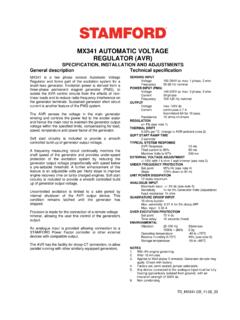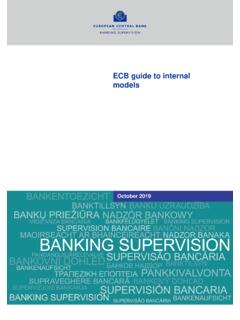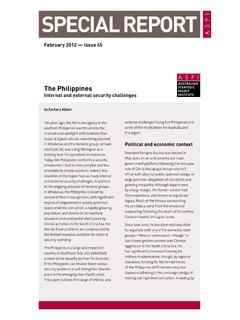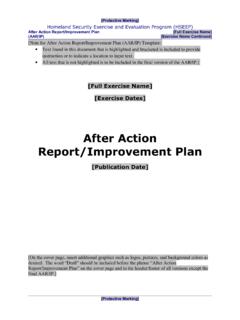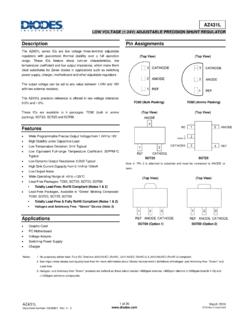Transcription of AGN 013 - Alternator Ratings and Overload
1 AGN 013 ISSUE C/1/10 Application Guidance Notes: Technical Information from Cummins Generator Technologies AGN 013 - Alternator Ratings and Overload Alternator Ratings AC synchronous generator ( Alternator ) Ratings are specified in accordance with national and international Standards (IEC 60034-22: AC generators for reciprocating internal combustion (RIC) engine driven generating sets). There are two types of rating that are specified, Basic Continuous Rating (BR) and Peak Continuous Rating (PR). Basic Continuous Rating (BR) Also referred to as Maximum Continuous Rating, Continuous Running Duty - Duty type S1 (IEC 60034-1) or Continuous Duty (NEMA MG1-32).
2 The Alternator will have a maximum continuous rating at which the machine may be operated for an unlimited number of hours per year, while complying with the requirements of the appropriate standards. For industrial use alternators , three Base Continuous Rating levels are offered, based on temperature rise limits and a standards ambient temperature of 40 C: Class H (125 C/40 C) Class F (105 C/40 C) Class B (80 C/40 C) Peak Continuous Rating (PR) This discrete constant loads rating equates to a Duty with discrete constant loads - Duty type S10 in IEC 60034-1 or Standby Rating in NEMA MG1-32.
3 Commonly known as the Peak Standby Rating, this rating level allows the permissible Alternator temperature rise to increase by a specified amount according to its insulation system thermal classification. For an insulation system with thermal classification H , the total temperature may be increased by 25 C for Alternator Ratings of < 5 MVA. The result is an increased rating at the expense of reducing the lifetime of the Alternator by between 2 to 6 times of the base continuous rating. AGN 013 ISSUE C/2/10 For industrial use alternators , two Peak Standby Rating levels are offered, based on temperature rise limits and ambient temperatures that provide a total temperature 10 C above the total temperature limit for the insulation system.
4 For low voltage alternators : Class H (150 C/40 C) Class H (163 C/27 C) Declaration of Duty Duty Types. To determine the correct size of Alternator for a particular application, it is important to know the characteristics of the loads to be applied, along with the sequence and duration of each load. IEC 60034-1 effectively guides a declaration of duty and offers Duty Types S1 to S10, to describe the cyclic duration of the loads to be applied: Continuous running duty Duty type S1 Short-time duty Duty type S2 Intermittent periodic duty Duty type S3 Intermittent periodic duty with starting Duty type S4 Intermittent periodic duty with electric braking Duty type S5 Continuous operation periodic duty Duty type S6 Continuous operation periodic duty with electric braking Duty type S7 Continuous operation periodic duty with related load/speed changes Duty type S8 Duty with non-periodic load and speed variations Duty type S9 Duty with discrete constant loads Duty type S10 To simplify Alternator selection for
5 The many and various load applications, Alternator manufacturers including Cummins Generator Technologies use two Duty Types, S1 and S10: Duty Type S1 Continuous running duty Base Continuous Ratings are used for this type of duty: Definition: Operation at a constant load maintained for sufficient time to allow the machine to reach thermal equilibrium. Duty Type S10 Duty with discrete constant loads this type of duty is defined for Standby application: Definition: A duty consisting of a specific number of discrete values of load (or equivalent loading) and if applicable, speed, each load/speed combination being maintained for sufficient time to allow the machine to reach thermal equilibrium.
6 Clarification of Relative Thermal Life Expectancy or TL Factor. Factor TL for the relative thermal life expectancy of the insulation system is an important integral part of the rating class. The exact value for the factor TL is marked on the rating plate. ISO 8528-1 refers to Emergency Standby Power (ESP) and Limited Time Prime (LTP) Ratings and accepts a reduction in life for the Generating Set. The limited time running power is the maximum power which a generating set is capable of delivering for up to 500h per year of which a maximum of 300h is is accepted that the operation at this rating will affect the life of the generating set AGN 013 ISSUE C/3/10 Peak Continuous Rating (PR) also referred to as Stand-By when offered by CGT, takes into account the fact that this introduces a reduction in service life and so does need to be qualified with a TL factor.
7 Based upon the above described duty cycle, a TL factor of is advised as being appropriate for the CGT range of alternators when they re offered for a PR rating. This TL factor advises that the life expectancy of the ac generator will be reduced to of the life expectancy of that same ac generator being operated at the published BR Class H rating. Example: Consider an Alternator with a BR Class H rating of 200kVA. This same Alternator has a published PR rating of 212kVA. If operated at the PR rating for 500h per year, the theoretical life expectancy of the Alternator will be reduced to when compared with operation at the BR rating and a life expectancy of 100% is theoretically expected.
8 Thermal Classification of the Insulation System and the Limit of Temperature Rise. Low Voltage (LV) alternators . The insulation system used on STAMFORD and AvK Low Voltage (LV) alternators has a thermal classification H (180 C). The half life expectancy of a Class H insulation system operated continuously at a temperature of 180 C is some 20,000 hours. Although this does not mean that the insulation system will fail after 20,000 hours. For a Class H insulation system, the limit of temperature rise by the resistance method for a machine indirectly cooled by air, is 125K for the Alternator s armature (Stator) and dc field (Rotor) windings.
9 For Classes F and B , the limit of temperature rise is 105K and 80K respectively for the above windings. The LV Alternator can be operated at lower temperature rise limits for the alternative thermal classifications F or B , with increased half life expectancy of 120,000 hours and 640,000 hours respectively. Medium Voltage (MV) and High Voltage (HV) alternators . The insulation system used on STAMFORD and AvK Medium Voltage (MV) and High Voltage (HV) alternators has a thermal classification F (155 C). The half life expectancy of a Class F insulation system operated continuously at a temperature of 155 C is some 20,000 hours.
10 Although this does not mean that the insulation system will fail after 20,000 hours. For a Class F insulation system, the limit of temperature rise by the resistance method for a machine indirectly cooled by air, is 105K for the Alternator s armature (Stator) and dc field (Rotor) windings. For Class B , the limit of temperature rise is 80K for the above windings. The MV/HV Alternator can be operated at the lower temperature rise limit for the alternative thermal classifications B , with increased half life expectancy of 120,000 hours. Operating conditions. AC synchronous generators are designed to operate within the following operating site conditions in accordance with IEC 60034-1.
